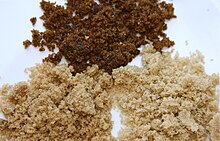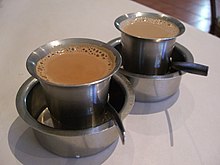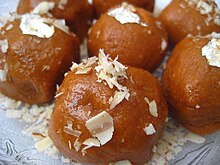
Muscovado is a type of partially refined to unrefined sugar with a strong molasses content and flavour, and dark brown in colour. It is technically considered either a non-centrifugal cane sugar or a centrifuged, partially refined sugar according to the process used by the manufacturer. Muscovado contains higher levels of various minerals than processed white sugar, and is considered by some to be healthier. Its main uses are in food and confectionery, and the manufacturing of rum and other forms of alcohol. The largest producer and consumer of muscovado is India.
Terminology
The English name "muscovado" is derived from a corruption of Portuguese açúcar mascavado (unrefined sugar). The Indian English names for this type of sugar are khandsari and khand (sometimes spelled khaand).
There is no legal definition of muscovado, and no international standards for it such as Codex Alimentarius or Protected Designation of Origin. This has led to manufacturers calling various sugar products "muscovado", and has led to confusion between muscovado, brown sugar, and even jaggery.
History
See also: History of sugar and Triangular tradeThe earliest known production of crystalline sugar began in northern India, after the introduction of sugarcane by Austronesian traders from Maritime Southeast Asia at around 1000 BCE. However, the exact date of the first cane sugar production is unclear. The earliest evidence of sugar production comes from ancient Sanskrit and Pali texts. Around the 8th century, Muslim and Arab traders introduced sugar from medieval India to the other parts of the Abbasid Caliphate in the Mediterranean, Mesopotamia, Egypt, North Africa, and Andalusia. By the 10th century, sources state that every village in Mesopotamia grew sugarcane.
The early modern era, which saw the European colonization of the Americas and Asia, also led to a rapid increase in sugar production. Sugar plantations were established in numerous places colonized by European nations, such as islands in the Indian Ocean, the West Indies and South and North America. Labor for these plantations were typically provided by indentured servants, slaves or kidnapped Pacific Islanders, which saw the rise of the transatlantic and Indian Ocean slave trades to supply enslaved laborers to cash crop plantations (including those producing sugar). Sugarcane was typically refined into raw sugar or distilled into rum on colonial plantations or sent elsewhere to be processed.
Raw sugar was brought to port in a variety of purities that could be sold either as raw sugar directly to market for producing alcohol, or as muscovado exported to sugar refineries in Europe and the Americas. In 19th-century Europe, raw sugars that had been refined enough to lose most of their molasses content were labeled as raw sugar and deemed higher quality, while poor quality sugars with a high molasses content were referred to as muscovado, though the term brown sugar was sometimes used interchangeably.
Production
Production methods
Traditional non-centrifugal sugar production Boiling sugarcane juice to make molasses
Boiling sugarcane juice to make molasses Pouring molasses for granulation by shearing
Pouring molasses for granulation by shearing
Muscovado is made from the juice of sugar cane that is evaporated until crystallisation occurs. The viscous suspension of crystals and mother liquor (molasses) is called massecuite. In the 19th century several techniques were used for sugar production. Muscovado is today produced by three main methods:
- The manual production method is to crystallise (granulate) massecuite by cooling it in pans and continuously shearing it by stirring with a large spatula (typically used in India) or by pressing it with the feet (typically used in Africa).
- The industrial centrifuge method invented in late 18th to early 19th century, in which massecuite is crystallised using a centrifuge to separate a crystal-rich mush that is drained of its molasses in a vessel under gravity.
- Modern industrial methods using a spray drier.
Massecuite is also used in the production of jaggery, in which it is set into moulds directly (without shearing, centrifuging, or spray drying).
Producer nations
Total global production is 10 million to 11 million tons annually by 20 nations. The largest producer is India (58%), followed by Colombia (14%), Myanmar (9%), Pakistan (6%), Brazil (4%), Bangladesh (3%), and China (3%).
In India, most khand (muscovado) is produced by 150 small to medium scale private manufacturers overseen by the Khadi and Village Industries Commission. These producers use traditional chemical-free organic manual shearing methods, each operating between 100 and 120 days per year, with a typical capacity of between 200 and 350 tons of sugarcane per day. The largest producing states in India are Maharashtra (58%), Bihar (6%), Karnataka (5%), Madhya Pradesh and Chhattisgarh (6%).
In Mauritius, muscovado is produced by centrifuging massecuite, from which the molasses is left to drain naturally.
In the Philippines, muscovado may be generated by any of the three methods. In the past, muscovado was one of the islands’ prominent export commodities, especially from the Negros island region in the Western Visayas, from the 19th century until the late 1970s.
The production of muscovado in the Philippines, Barbados, and elsewhere had experienced a long period of decline when large mills took over sugar production from small farmers with small mills. In recent years an increased consumer interest in healthy and organic foods has revived interest in muscovado, creating a new market for small mills.
Nutrition
When produced under regulated conditions muscovado is nutritionally richer than sugars, and retains more of the natural minerals in sugar cane juice, as shown in the following nutritional analysis (per 100g):
- Total mineral salts 740mg max.
- Phosphorus (P) 3.9mg max.
- Calcium (Ca) 85mg max.
- Magnesium (Mg) 23mg max.
- Potassium (K) 100mg max.
- Iron (Fe) 1.3mg max.
- Calories 383 kCal
Uses
Food and confectionery

Muscovado is used as an ingredient in food and confectionery, and as a sweetener in hot beverages. It is very dark brown and is slightly coarser and stickier than most brown sugars. Muscovado takes its flavor and color from its source, sugarcane juice. It offers good resistance to high temperatures and has a reasonably long shelf life.
Muscovado sugar can be substituted for brown sugar in most recipes by slightly reducing the liquid content of the recipe.

The use of khand in India in making sweets has been traced to at least 500 BC, when both raw and refined sugar were used.
Along with gur, khandsari unrefined sugar is India's traditional sweetener, commonly used in traditional recipes for masala chai (spiced Indian tea), eating with roti by mixing with melted ghee, traditional Indian sweets that require sugar such as kheer (Indian rice pudding), gur or khandr chawal (sweetened rice) or laddu.
Muscovado is often used to sweeten coffee.

Alcohol
A significant proportion of India's production of Khandsari (muscovado) is used for the illicit production of desi daru, a distilled alcoholic drink.
Ayurveda medicine
Khandsari (muscovado) is used in traditional Ayurveda medicine to aid blood purification, digestion, bone health and the lungs.
See also
- Sugar
- Brown sugar
- Jaggery
- Rock candy
- Indian Institute of Sugarcane Research
- Indian Sugar Mills Association
References
- ^ "Muscovado Sugar". Archived from the original on 17 April 2015.
- ^ Prince, Rose (9 November 2011). "The sweetest flames: Brown sugar from Mauritius". The Daily Telegraph. London. Retrieved 19 June 2017.
- Education World: The Human Development Magazine. 2004. Volume 6, Issues 7-12, p.78
- Souvenir, Silver Jubilee Celebrations and 22nd Annual Convention, Indian Society of Agricultural Engineers, 29-31 Oct. 1985 Held at Central Institute of Agricultural Engineering, pp.116
- ^ Jaggery Nutritional Value, Nutrition Facts & Analysis, Ayur Times, Dr. Jagdev Singh, 27 Nov 2014
- ^ Bhardwaj, Amit (25 March 2013). "The Gur and Khaandsri Industry & its practical impact on Indian Sugar Consumption level" (PDF). Indian Sugar Mills Association. New Delhi: World Association of Cane and Beet Growers Conference. Archived (PDF) from the original on 20 June 2015.
- ^ Dhawan, B. D. (April 15, 1967). "The Traditional versus the Modern: Case of Indian Sugar Industry". Economic and Political Weekly. 2 (15): 723, 725–7. JSTOR 4357817.
- "muscovado". Oxford English Dictionary (Online ed.). Oxford University Press. (Subscription or participating institution membership required.)
- "muscovado". Merriam-Webster. Retrieved 20 April 2019.
- Daniels, Christian; Menzies, Nicholas K. (1996). Needham, Joseph (ed.). Science and Civilisation in China: Volume 6, Biology and Biological Technology, Part 3, Agro-Industries and Forestry. Cambridge University Press. pp. 177–185. ISBN 9780521419994.
- See:
- George Watt (1893), The Economic Products of India, W. H. Allen & Co., Vol 6, Part II, pages 29–30;
- J.A. Hill (1902), The Anglo-American Encyclopedia, Volume 7, page 725;
- Thomas E. Furia (1973), CRC Handbook of Food Additives, Second Edition, Volume 1, ISBN 978-0849305429, page 7 (Chapter 1, by Thomas D. Luckey);
- Mary Ellen Snodgrass (2004), Encyclopedia of Kitchen History, ISBN 978-1579583804, Routledge, pages 145–146
- Watson, Andrew. Agricultural innovation in the early Islamic world. Cambridge University Press. p. 26–7.
- "Triangular Trade". National Maritime Museum. Archived from the original on 25 November 2011.
- Abbott, Elizabeth (2009) . Sugar: A Bittersweet History. London and New York: Duckworth Overlook. ISBN 978-0-7156-3878-1.
- "Slavery in Rhode Island". Slavery in the North.
- ^ Accum, Fredrick Christian, Culinary Chemistry Exhibiting the Scientific Principles of Cookery (1821), London, p. 289.
- Orr, W. (1844), The Magazine of Domestic Economy, Vol. 5, p. 107.
- Reed, W. (1866), The History of Sugar and Sugar Producing Plants, pp. 82–89.
- Martineau, G. (1918), "Sugar from several points of view", in The Chemical News and Journal of Industrial Science, 117.
- ^ "Muscovado Sugar" (PDF). Datupagles.com. Retrieved 2016-07-30.
- ^ Larkin, W. (1993). "Sugar and the Origins of Modern Philippine Society". pp. 55–58.
- ^ Roger Knight, G. (2013), Commodities and Colonialism: The Story of Big Sugar in Indonesia, 1880–1942, p. 4.
- Larkin, John A. "Sugar and the Origins of Modern Philippine Society". Escholarship.org. Retrieved 2008-12-01.
- "Muscovado Sugar : A New Sunshine Industry". Agriculture Business Week. 2008-07-24. Archived from the original on 2008-10-13. Retrieved 2009-05-27.
- Zhu, Agnes (24 October 2014). "Refined sugar vs. unrefined sugar". The Daily Californian. Berkeley, CA, USA.
- "Muscovado Sugar". Sugarindia.com. Archived from the original on 9 April 2016.
- ^ Michael Krondl, Sweet Invention: A History of Dessert, Chicago Review Press, ISBN 978-1556529542, pp. 34–35
- ^ "Jaggery – A Traditional Indian Sweetener", P. V. K. Rao, M. Das S. K. Das, Indian Journal of Traditional Knowledge, 2004, vol. 2007 6(1), January 2007, p. 95
- "Policy Brief – Technological and Policy Options for Modernization of Jaggery Industry in India", Indian Council of Agricultural Research, L. S. Gangwar, S. Solomon & S. I. Anwar, p .2
External links
 Media related to Muscovado at Wikimedia Commons
Media related to Muscovado at Wikimedia Commons- Video: Centrifugal method of Khand production in India
- Video: Gur (Jaggary) and Khand (Muscovado) making in India using traditional method.
| Sugar as food commodity | |||||||||
|---|---|---|---|---|---|---|---|---|---|
| List of sugars and sugar products | |||||||||
| Chemistry | |||||||||
| Sources | |||||||||
| Products |
| ||||||||
| Industry |
| ||||||||
| History |
| ||||||||
| Culture | |||||||||
| Related | |||||||||
| Research | |||||||||
